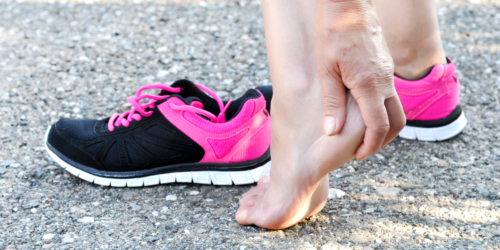What could be causing my heel pain?
Heel pain may be extremely uncomfortable, but one thing it is not is rare. According to the American Podiatric Medical Association (APMA), four out of ten individuals in the U.S. experience heel pain each year. The entire foot bears a tremendous amount of stress. When simply walking, every step we take creates a force close to 1.25 times our body weight, and, with running, that force becomes three to four times greater. This makes the heel very vulnerable to injury and the resulting pain.
Common causes of Heel Pain
Besides basic overuse or injury, there are a wide variety of conditions and issues that can be responsible for heel pain. Some of the more common causes include:
- Plantar fasciitis – inflammation of the plantar fascia due to it becoming over stretched
- Heel bursitis – inflammation of the bursa, a fibrous sac full of fluid at the back of the heel
- Heel bumps – formation of bumps or too much bone on the heel
- Tarsal tunnel syndrome – compression or pinching of a large nerve on the back side of the foot
- Chronic inflammation of the heel pad
- Stress fracture – fracture caused by repetitive stress, often the result of strenuous exercise, sports or manual work
- Severs disease – commonly seen in children from age 7 to 15, caused by overuse and repetitive trauma to the growth plates of the heel bone
- Achilles tendonitis – progressive degeneration of the Achilles tendon
- Achilles tendon rupture – torn tendon in the heel cord behind the ankle
- Bone bruise
- Bone cyst
- Gout – high levels of uric acid in the blood cause urate crystals to build up around the joints, which causes inflammation and severe pain
- Morton’s neuroma – swollen nerve in the ball of the foot
- Osteomyelitis – infection of the bone or bone marrow
- Peripheral neuropathy – often associated with diabetes, nerves outside of the brain and spinal cord become damaged, causing pain and numbness
- Rheumatoid arthritis – chronic, progressive and disabling auto-immune disease condition that causes inflammation and pain
- Wearing high heeled shoes
When heel pain is present, it is important to determine the cause as quickly and accurately as possible so that a treatment plan can be developed and put in place. The best course of action is to consult with your podiatrist. According to the APMA, “69% of American heel pain sufferers seek out information regarding their condition, but only 17% do so from podiatrists. The Internet (25%), doctors other than podiatrists (25%), friends and family (25%) are more commonly consulted.” It is not surprising that, for most of these people, their problems may continue to escalate.
The good news is that heel pain can be conservatively treated with good results. When treating heel pain, it is essential to first identify the source of your pain. At Country Foot Care we use state-of-the-art diagnostic services. These include digital x-ray imaging, diagnostic ultrasound studies, fluoroscopy, as well as in-house vascular diagnostics, including PADNET Doppler, ABI, and CVI Venous studies.
At Country Foot Care, we combine technology with years of foot care experience to help you understand both the condition that is giving you problems and the holistic treatment we recommend. Not only do we offer individualized treatment plans and personal attention in a state-of-the-art facility, but we also have an extensive medical shoe store at each location where you can find shoes designed for diabetics.
To schedule an appointment at one of our Country Foot Care locations, Mineola or Williston Park, please use our online form by clicking here.


